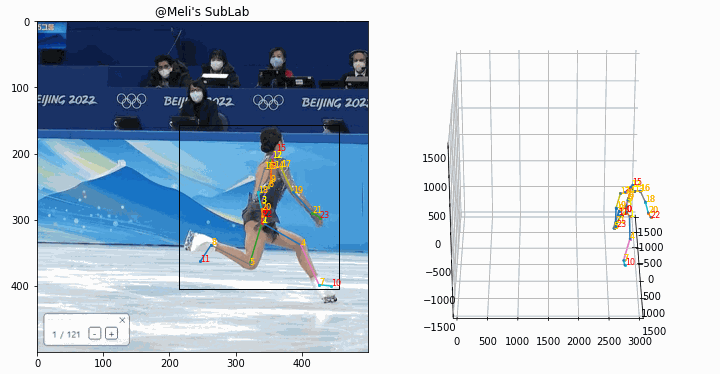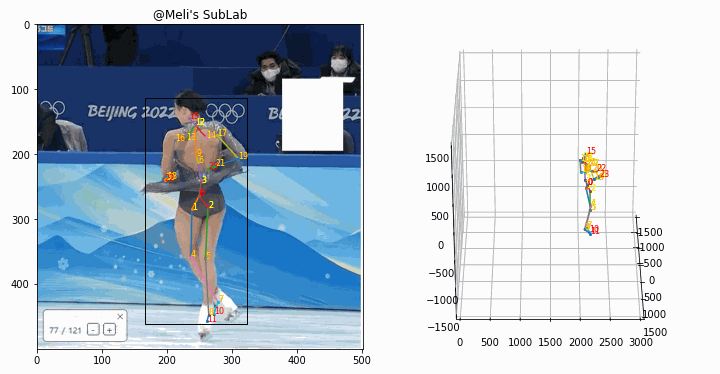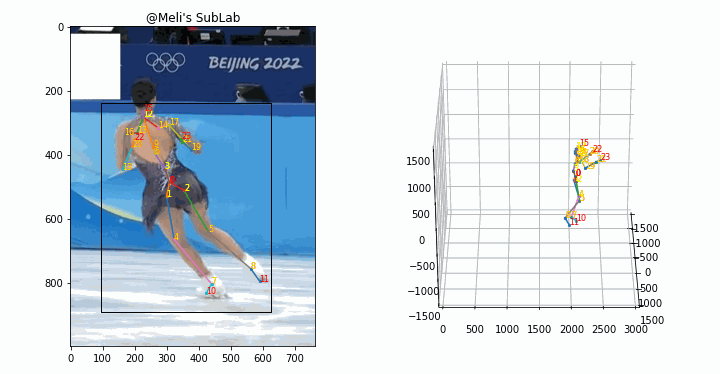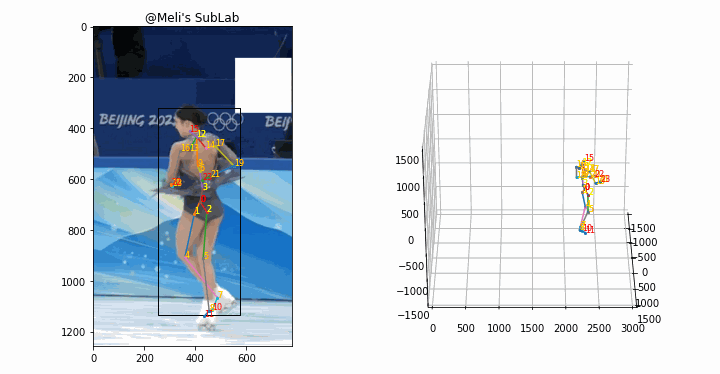- Published on
🛠 | Technical Analysis of You Young's Triple Axel Scoring at the 2022 Beijing Olympics
Abstract
This study presents a technical analysis of You Young's triple axel (3A) execution during the 2022 Beijing Olympics short program, which received a downgrade marking from the technical panel. Using computer vision pose estimation techniques, we examine the rotation measurement criteria applied in figure skating judging to assess the validity of the technical decision.

Introduction
Figure skating technical judging relies on precise assessment of jump rotation, particularly for complex elements such as the triple axel. According to the official protocol from You Young's short program at the 2022 Beijing Olympics, the triple axel element received a downgrade (<<) marking, indicating the judges determined the jump was under-rotated by more than 90 degrees.

Technical Judging Criteria
The International Skating Union (ISU) defines three categories for jump assessment: fully rotated, under-rotated (<), and downgraded (<<). The technical panel evaluates jumps based on the rotational deficit upon landing, measured as the angular difference between the takeoff and landing orientations.

For counterclockwise rotation jumps, the landing baseline is established at the 12 o'clock position. A jump is considered:
- Fully rotated: Less than 45° rotational deficit
- Under-rotated (<): 45° to 90° rotational deficit
- Downgraded (<<): Greater than 90° rotational deficit
Research Motivation
Controversy surrounding judging decisions has prompted debate within the figure skating community regarding the subjective nature of rotation assessment. The determination of takeoff and landing reference points can significantly impact the measured rotational deficit. This analysis employs quantitative methods to examine the technical merit of the judging decision.
Methodology
Technical Setup
This analysis employed computer vision pose estimation to quantify rotational measurements. The following computational environment was utilized:
- Pose Estimation Model: Metrabs - Multi-person absolute 3D human pose estimation
- Hardware: NVIDIA GeForce GTX 1060 Ti, Intel Core i7 processor
- Software Environment: Windows 10, Google Colaboratory
- Analysis Framework: Python-based computer vision pipeline
Experimental Design
Two experimental trials were conducted to examine different interpretations of takeoff reference point determination, as debated within the figure skating community.
Trial 1: Skidding Initiation as Takeoff Reference
The first trial establishes the takeoff reference point at the initiation of the characteristic axel skidding motion on the ice surface.
Biomechanical Analysis
 |  |
Using pose estimation, directional vectors were calculated for both feet during the critical phases:
- Red vector: Left foot orientation at takeoff
- Blue vector: Right foot orientation at landing

Quantitative Results
The angular measurement between takeoff and landing orientations yielded approximately 88°. Applying the ISU standard calculation where the landing baseline represents 180° rotation from takeoff orientation, the total rotational deficit was calculated as:
Rotational deficit = 180° - 88° = 92°
This measurement exceeds the 90° threshold, supporting a downgrade (<<) classification according to ISU technical guidelines.
Trial 2: Advanced Takeoff Reference Point
Critics of Trial 1 argued for a more forward takeoff reference point, necessitating a second experimental approach.
Biomechanical Analysis
 |  |
Community consensus validated the landing reference point from Trial 1, while proposing an alternative takeoff reference point positioned further forward in the jumping sequence.

Quantitative Results
Using the revised takeoff reference point, the angular measurement between orientations yielded approximately 1°. Incorporating potential measurement error (±5°), the analysis considered a range of 1° to 6°. Applying the ISU calculation framework:
Rotational deficit = 180° - (1° to 6°) = 174° to 179°
However, this interpretation suggests a rotational deficit of 186°, which would indicate an over-rotation scenario rather than under-rotation, contradicting the technical panel's assessment.
Discussion
Analysis Implications
The comparative analysis reveals the critical importance of reference point selection in technical judging assessment. Trial 1, utilizing the skidding initiation as takeoff reference, yielded measurements consistent with the technical panel's downgrade decision (92° rotational deficit). Conversely, Trial 2's alternative reference point produced results contradicting the official assessment.
Technical Judging Considerations
The substantial variation in measured rotational deficit (92° vs. 186°) demonstrates the inherent challenges in subjective reference point determination. This variability underscores the need for standardized, objective measurement protocols in figure skating technical assessment.
Broader Context in Sports Analytics
Recent developments in sports technology have highlighted the potential for AI-assisted judging systems. Following Yuzuru Hanyu's 2021 graduate thesis advocating for artificial intelligence integration in figure skating judging, there has been increased interest in objective technical assessment methods. However, the implementation of such systems must address fundamental questions regarding fairness and standardization across diverse competitive contexts.
Conclusion
This quantitative analysis demonstrates that the validity of rotation assessment in figure skating is highly dependent on reference point methodology. While Trial 1 supports the technical panel's decision through objective measurement, the significant discrepancy with Trial 2 highlights systematic issues in current judging protocols.
The development of standardized, technology-assisted evaluation methods could potentially reduce subjective variability in technical assessment. However, successful implementation requires careful consideration of measurement protocols, technological reliability, and preservation of the artistic elements that define figure skating as both sport and performance art.
Future research should focus on establishing consistent biomechanical criteria for takeoff and landing reference points, potentially incorporating multi-angle video analysis and real-time pose estimation technologies to enhance judging accuracy and transparency.
"Athletes who violate doping cannot compete in the game. This principle must be observed without exception. All players' efforts and dreams are equally precious." - Yuna Kim
- Authors

- Name
- Amelia Young
- GitHub
- @ameliacode